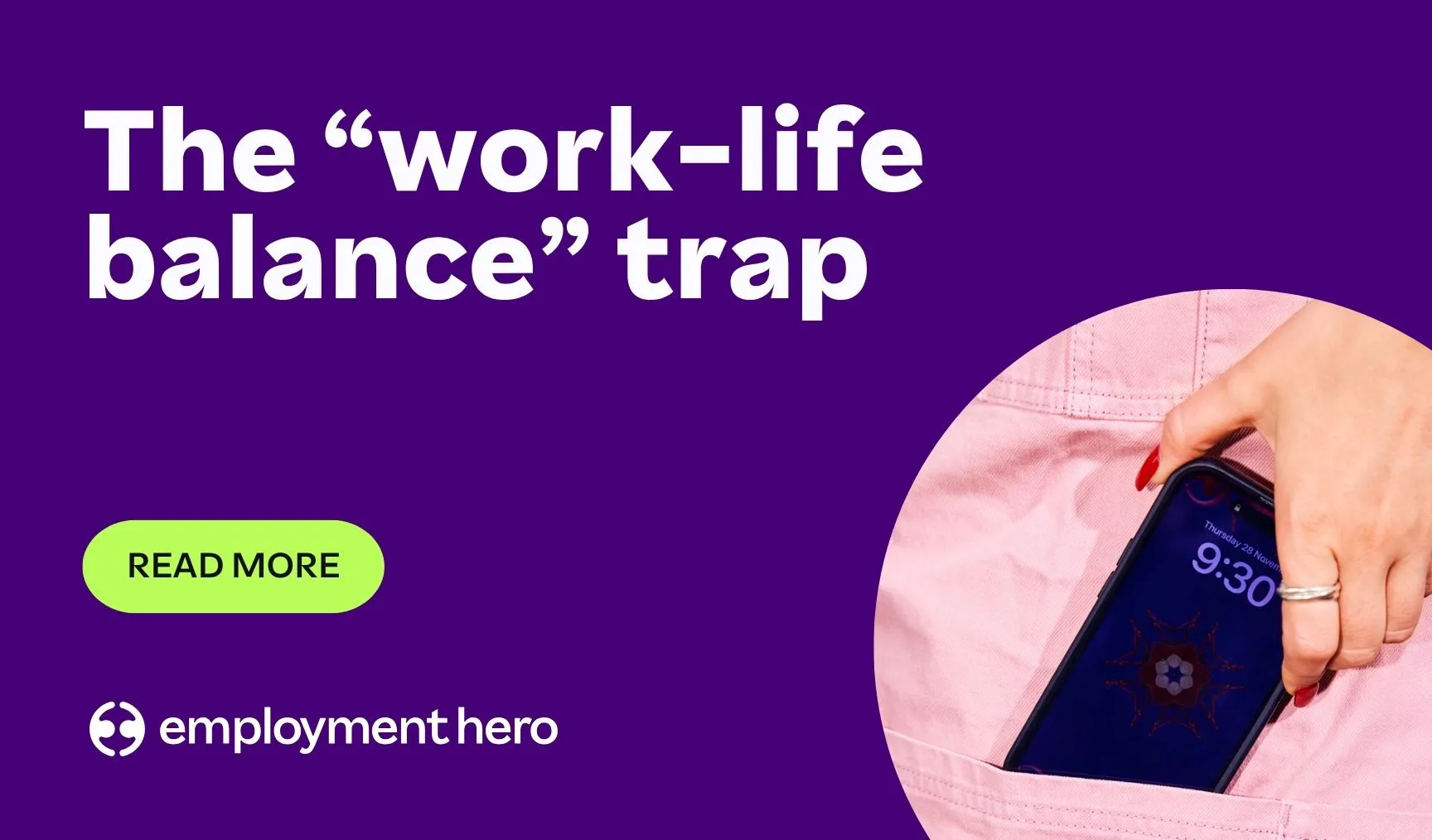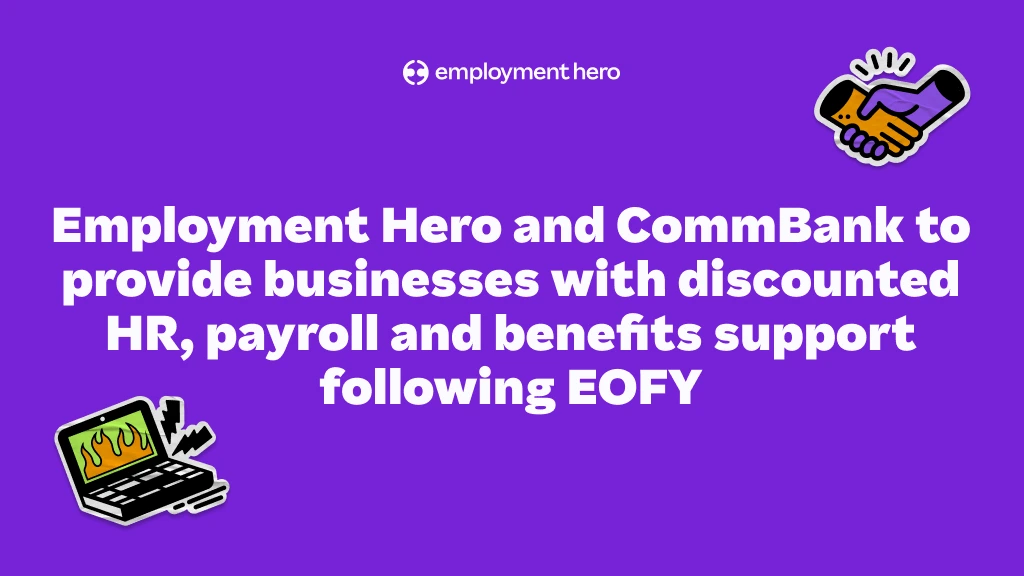How to identify ‘flight risk’ employees
With the Great Resignation phenomenon generating more flight risk employees than ever, how can we identify and retain team members that may be looking elsewhere?

There’s no worse feeling for a manager than being blindsided by an employee’s resignation. One day, you’re kicking goals together and planning for the future. Next, they’re organising a mysterious meeting and wishing you ‘all the best for the future’. What went wrong?
An unsatisfied employee can be hard to spot, but your team member may be giving off warning signs. With the Great Resignation phenomenon generating more flight risk employees than ever, it’s extremely important to recognise the tell-tale signals of an employee that may have one foot out the door and what you can do to keep them under your roof.
What is a ‘flight risk’ employee?
A ‘flight risk’ employee is one that may be preparing to leave your business. They may be feeling disengaged or curious about another opportunity, which might have caused them to start thinking about alternative options.
Flight risk employees may be in the process of re-evaluating their decision to stay within the company and are constantly assessing other companies for job opportunities.
Unfortunately, flight risk employees are bad news for any business. Their actions have the possibility of impacting turnover rates and disrupting the team dynamic.
The more flight risk employees a business has, the more money it will lose in turnover costs and lost productivity. The longer it takes to get someone new on board to replace a departed flight risk, the more a business’s bottom line takes a hit.
Why would an employee become a flight risk?
While there aren’t always justifiable reasons for at-risk employees, the common reasons could be due to pay differences, poor employee satisfaction, or because they are working through a personal problem.
Flight risk employees may also look for a company that offers a better work-life balance or a higher salary. Or, many employees could be simply wondering if the grass really is greener on the other side.
Here are some reasons why top-performing employees choose to leave a company:
1. Going through a major life change
There is any number of big life events that can cause employees to re-evaluate their place in an organisation.
Take general life milestones like; moving, becoming a parent, discovering a new passion or moving towards retirement – and then add the unique events of the last few years. Recovering from Covid-19, taking on additional caring responsibilities or adjusting to remote working, there are a lot of changes to absorb in an already overwhelming period.
These personal events can change employees perspectives and priorities, especially when it comes to working.
Our Wellness at Work Report 2022 found that employee’s relationship with their professional life has shifted; 44% agreed that Covid-19 had decreased the importance they placed on their careers.
2. Feeling stuck in their job
Have you ever been in a role which felt like a dead end? There might be nothing left to learn, a lack of development opportunities and no new projects to get stuck into; it’s easy to fall into a working rut. You can quickly feel like you’ve stepped onto the hamster wheel.

Humans, as a general rule, like to feel like we’re always progressing. There’s nothing that’s more demotivating than feeling like you’re out of options and falling into a monotonous day-to-day.
If you suspect your employee might be outgrowing their role, check out our guide on 5 signs your employee is outgrowing their role. It offers insight into recognising this issue and addressing it effectively.
3. Bigger and better offers from other companies
If you’ve noticed a few LinkedIn InMail’s in your inbox lately, there’s a very high chance that your team members have too.
With the chaos of the Great Resignation, recruiters are working overtime to secure new talent. There’s every chance that your employees are being poached by another great company, and they may be saying all the right things to get your employee excited about their opportunity.
Recruiters can be very convincing. If your employee is feeling even slightly unsatisfied in their current role, they might be open to making the switch – especially when there is a pay gap involved.
If you’re dealing with a flight risk employee who seems to be lured away by better offers, consider strategies to combat this. Our resource on how to stop brain drain & retain employees offers practical tips to retain your top talent.
4. Increased negativity
Companies, and the individuals that work within them, have been through a lot recently.
After tackling so many hurdles, it makes sense that company culture and morale might be running at a loss.
Our research shows that over half of the workforce has felt a sense of burnout in recent times. This feeling of intense fatigue can really hinder motivation and make teamwork more challenging.
It’s a vicious cycle. The more an employee feels burnt out, the more likely they are to be overwhelmed with negativity, which can be extremely contagious to others. They say that one bad apple can spoil the bunch, and in this case, the bunch is the rest of your team.
This is why we often see waves of turnover; bad vibes catch on quickly and spread like wildfire.
5. A perception of low pay
When was the last time you reviewed your employees’ salaries?
In 2022, there are more resources than ever for your team to examine and benchmark market salary packages for their roles and industry. We’re also seeing major rates of inflation and wage growth is far from keeping up with the rising cost of living.
These three big factors should have you thinking about your team’s salaries.
- When was the last time they had a salary review?
- What does the employee’s performance appraisal look like?
- Does their remuneration package seem on par with their current performance or in line with other roles in the same position out there?
Our survey found that only 39% of employees are comfortable discussing their finances with their managers. There’s a good chance they will never come to you for a conversation about being paid fairly, they may just jump ship instead.
Don’t lose your high achievers go over a salary conversation that didn’t happen.
For additional insights on reducing staff turnover and improving retention, consider our employer’s guide to reducing staff turnover and improving retention. This free eBook provides strategies to tackle turnover effectively.
6. A change in management
One of Glassdoor’s top 10 reasons why employees resign, a change in the organisation structure or in management can wreak havoc on turnover rates. This usually falls to a lack of proper communication and consideration for how the employee will be affected.
Change management can be done, and it can be done well – or not so well. If you’re planning any major upheaval within the organisation, it’s important that employees have a transparent understanding of what changes are being made and why.
It’s critical to map this out and have a game plan for the proposed changes to keep your staff feeling supported. If done poorly, this is where you’ll see your top players head for the door.
Read more: Dealing with bad managers in your organisation
7. They’re a job jumper
Sometimes – it’s not you, it’s them.
Some employees like to hop from job to job. They’re always looking for more, and they’ve got their eyes on greener pastures.
If you have a feeling this might be the case during the hiring process, be sure to ask honest questions about their job movement and conduct thorough reference checks.
How to spot flight risk employees
Now we understand their motivations, how can we identify team members who are feeling this way?
Here are the signs and signals to identify flight risk employees:
Lack of employee engagement
When employees are engaged, they feel motivated and have a sense of purpose around the work that they do. They actively contribute to discussions and aren’t afraid to share their ideas in brainstorming sessions.
Disengaged employees would do the opposite. It might be tough to get a sense of motivation, they may have a lack of understanding of why they are doing a certain task. They lack purpose and as a result, lack direction.
If your team member frequently keeps their camera and mic off, fails to contribute during discussions and seems to have lost interest in their tasks – it’s highly likely that their employee engagement has dropped.
They may no longer be excited about the work that they are doing, and they may have one foot out the door already.
To address disengagement, consider workplace coaching. Our article on why workplace coaching is essential to engaged employees can provide you with strategies to enhance employee engagement.
Read more: Why workplace coaching is essential to engaged employees
Constant absence
Everybody will need a sick or mental health day every once in a while, and annual leave should be actively encouraged.
However, if your employee is often absent, leaving early without justification or taking really long lunches on a regular basis – it could signal that their mind is on other opportunities.
Read more: Questions check-in with employees during 1:1s
Missing deadlines or tasks
There are plenty of good reasons for missing deadlines or dropping the ball on tasks – it happens to everybody.
As it is with employee absences, it’s all about looking for trends. Do they have justified reasons for a drop in quality of work? Have they changed roles or taken on new projects that they may be adjusting to?
They may just need additional support. If this is the case, it’s also worth having a conversation about how they’re coping mentally and providing details about your company’s employee assistance program.
However, if they no longer seem to care about missing deadlines or aren’t interested in tasks that are being delegated to them, it could be a sign that their work is no longer working for them.
Read more: Use a performance improvement plan to get them back on track
Additional push-back
Fielding more push-back than usual from your team can be a surprise, but you should always listen carefully.
A flight risk employee may be trying harder to improve their situation before they make a move to another company. Maybe they are testing the waters on their preferred way of doing things or looking to see if they can have some sway in business operations.
Consider their feedback carefully and try to understand the motivations behind their request.
Disinterest in development opportunities
If an employee has already checked out mentally, any new challenges might lose their appeal. They may have little interest in career progression and greater responsibilities if they’re seeking fulfilment elsewhere.
If they previously seemed excited about climbing the ladder at your company, but now they’re not responding to opportunities, this is a big red flag.
Read more: Do you have a mentorship program in place?
How can managers get flight risk employees back on track?
As long as your employee hasn’t signed on at another business, you have an opportunity to retain employees and win them back.
1. Make your team’s experience consistent throughout their employment
During the recruitment process, HR professionals are focused on winning over amazing candidates.
It’s important that when the recruitment and onboarding process is over and the person is getting into their everyday work, the employee experience (EX) isn’t forgotten.
Learn more about what makes a great employee experience and why it’s so important, and see how employee engagement software can help.
2. Show your appreciation and celebrate wins (even small ones)
Recognising your team’s work – no matter how big or small their win is – is incredibly important in creating a good environment.
Reward and recognition is the key to employee engagement. Studies have shown that for every piece of criticism that an employee receives, whether constructive or not, six pieces of positive reinforcement are needed to counteract it. Recognition spurs motivation, loyalty and team morale.
Put yourself in the shoes of a potential flight risk employee; do you really want to switch jobs when you feel nurtured and appreciated in your current role? It can make the uncertainty of a new team culture at a different job much less appealing.
As a leader, think about the full spectrum of recognition you have to give.
From a personal thank you message appreciating their effort to showing your recognition publicly on a company feed (like on the Employment Hero app), right through to taking them out for a celebration lunch. With so many options for celebration, no great work should go unnoticed.
Read more: How to give positive feedback to employees
Cheering your team on, always.
3. Always prioritise employee development
Jump back into those flight risk shoes. You feel like you’ve reached a dead end in your current organisation. Maybe you were never given a professional development plan, and you feel like every day is falling into a monotonous routine. To put it simply – you’re bored.
But what if one day your manager sits you down in a one-on-one meeting and asks you what you want to do at the company. Together, you put together a list of goals – and some positive outcomes of where achieving those objectives could take you.
In six months, you could be managing a staff member, taking on more responsibilities and a more significant position within the business.
Suddenly, you’re not so interested in another job opportunity. You have something to work towards and exciting things ahead. You feel less like an employee flight risk and more like your career is taking off.
4. One-on-one meetings are key
We’re already hinted at one-on-one meetings, but they really are a leader’s secret weapon in identifying and resolving flight risk.
One-on-one (1:1) meetings are an effective way to evaluate job performance as managers, and their direct reports come together for a confidential catch-up on a weekly or fortnightly basis.
By tackling these 1:1 questions, you are able to sense-check where your employee is at and look out for any red flags.
1:1s provide a secure environment for both an employee and manager to raise any concerns or issues. It’s a great place to discuss development, share feedback and problem-solve any issues.
Download our 1:1 meeting template.

Teamwork five!
5. Look at what similar companies in your industry are doing
When you’re running a business, it’s not only important to keep an eye on your industry competitors to retain customers, but also to retain staff.
It’s a lot easier to convince employees to stay when you’re outperforming others in your industry in terms of employee experience. Reflect on the businesses that employees have left your team for.
What makes them more appealing? Is it:
- A better benefits package
- Significant salary differences
- A great employee culture
- Team programs
Take a look at your competitors and their LinkedIn and Glassdoor profiles to see what they’re using to capture an employee’s attention.
How does your business stack up?
Master the art of retention
Having an amazing retention strategy can save your business hundreds of thousands in turnover costs and make your company an amazing place to work.
For more information on how you can retain top talent, watch our exclusive HR Masterclass with Employment Hero’s Chief People Officer Alex Hattingh and CEO Ben Thompson, joined by expert Cassie Roma of CR&Co.
Related Resources
-
 Read more: The ‘work-life balance’ trap: Why promising it is hurting your SME recruitment (and what to promise instead)
Read more: The ‘work-life balance’ trap: Why promising it is hurting your SME recruitment (and what to promise instead)The ‘work-life balance’ trap: Why promising it is hurting your SME recruitment (and what to promise instead)
For growing SMEs, work-life integration is a sustainable way to support your team and attract top talent. Explore how your…
-
 Read more: Job ad guide: How to attract top candidates
Read more: Job ad guide: How to attract top candidatesJob ad guide: How to attract top candidates
Looking to hire your perfect match? The way you pitch your open role can be the difference between landing or…
-
 Read more: Employment Hero and CommBank to provide businesses with discounted HR, payroll and benefits support following EOFY
Read more: Employment Hero and CommBank to provide businesses with discounted HR, payroll and benefits support following EOFYEmployment Hero and CommBank to provide businesses with discounted HR, payroll and benefits support following EOFY
Eligible CommBank Yello for Business customers will get the first 3 months free on any Employment Operating System subscription with…






















